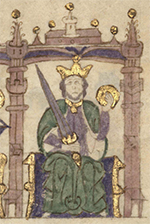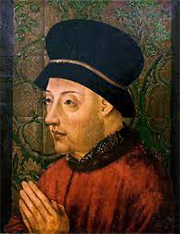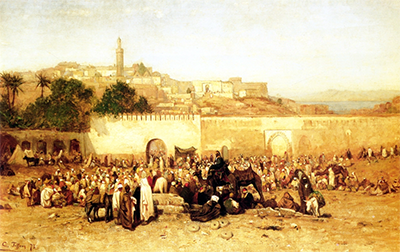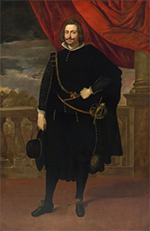The Cortes: Portugal's Medieval Parliament
The Cortes was a Parliament-style gathering of representatives of the various clergy, nobility, and middle class people from around the country of Portugal. Monarchs issued summons for such gatherings intermittently for nearly five centuries. 
Afonso II (left), ruling in the 13th Century, is the first known monarch to summon a Cortes. This occurred in Coimbra in 1211. As a result, the country had its first body of written laws and its first set of ambassadors, sent by Afonso to establish relations with other European kingdoms. The first representative Cortes assembled at Leiria at the behest of King Afonso III in 1254. He insisted that its representation be relatively widespread. Among the results were laws to curb the nobility's ability to repress the poor and measures to prevent people from being arrested without proper cause. He also summoned the Cortes in Guimarães, in 1256 and 1261, and in Santarém, in 1273. By and large, the monarchs of Portugal summoned the Cortes sparingly. Far and away the reason most cited was the approval of taxation, commonly to finance war efforts. However, delegates to Cortes assemblies could also pass on to the royal council petitions for such things as declaration of town privilieges or redress in the terms of alleged abuses by officials. King Denis summoned the Cortes six times (1281 in Évora, 1283 in Coimbra, 1285 in Lisbon, 1288 in Guimarães, 1289 in Lisbon and 1323 in Libson), primarily on matters of religion and the country's relations with the papacy. Also summoning the Cortes six times was Afonso IV. Three of those assemblies met in Santarém (1331, 1334, and 1340); it was at the last of those that the delegates gave their approval of the marriage to the heir apparent, Pedro, to Constance of Peñafiel, paving the way for Portuguese involvement in a power struggle in nearby Castile. Other meetings of the Cortes summoned by Afonso IV took place in Évora (1325) and Lisbon (1352). That heir apparent became king, in 1357, and ruled for a decade. Pedro I summoned the Cortes just once, in 1361, at Elvas. He succeeded in increasing the king's power at the expense of the Catholic Church, requiring church leaders to gain his approval before issuing papal bulls, or pronouncements. Many monarchs summoned the Cortes in order to appear to have the support of the populace at large while enacting various proposals, including the raising of taxes; and in many cases, the assemblies ratified the king's wishes. Such was not the case in all of the eight times that Ferdinand I summoned the Cortes (1331 in Lisbon, 1372 in Porto, 1372 in Leiria, 1373 in Santarém, 1375 in Atouguia, 1376 in Leiria, 1380 in Torres Novas, and 1383 again in Santarém). 
King John (João) I holds the record for summoning the Cortes the most times. In his 48 years on the throne, he called them to assemble 28 times. The first, in 1385 in Coimbra, acclaimed him as king, to end a succession crisis that devolved into a war involving neighboring Castile. The second, just a year later in Braga, established a tax to pay for that war. Two later assemblies in Coimbra, one in 1391 and one in 1398, mandated that Jews had to wear a red Star of David and that all debts were to paid in real (not debased) coinage, respectively. Other meetings under this monarch were these:

A large-scale expedition into North Africa was the subject of two summonings of the Cortes by King Duarte, known as Edward. That monarch issued four summons in his five years on the throne. The first was a wholesale review of the legal system. The third, in 1436 in Évora, authorized funds for a military mission to take the city of Tangier. The failure of that mission resulted in the 1437 summoning, in Leiria, to ratify a treaty that Edward had made with the victorious Moroccans, who had taken Edward's youngest brother, Ferdinand, hostage. The Cortes refused to go along. Edward's death in 1438 left his young son, Afonso, as king. Two regents (his mother, Eleanor, and his uncle Pedro) governed for him for a decade until he came of age, and then he governed in his own right for 33 years more. During this time, the king or his regents summoned the Cortes 22 times. The first assembly, in Torres Novas in 1438, ratified the terms of Edward's will that named Eleanor as regent. That assembly passed a law that required the Cortes to be summoned annually; the law was largely ignored. An assembly the following year in Lisbon named Pedro as regent. Afonso himself was the target of the 1451 gathering in Santar#233;m, as the delegates reprimanded the king for passing laws outside their jurisdiction. Other summons issued by Peter and Afonso were these:
Then came a number of routine summonings:
Catherine of Austria, acting as regent, in 1562 summoned the assembly in the name of the young Henry V, who himself issued two summonses, in 1579 and 1580. Both of those had to do with succession, the former (in Lisbon in 1579) ratifying the way forward after the death of Sebastian and the latter (in 1580 in Almeirim) paving the way for the creation of the Iberian Union under Spain's King Philip II, who reigned as Philip I of Portugal. The Spanish monarch called his own Cortes in 1581 to solidify his rule over Portugal; the assembly, in Tomar, did so. Two years later, another assembly, in Lisbon, approved Philip's son, also named Philip, to be King Philip II of Portugal. In the same vein, that king summoned the delegates in 1619 in Lisbon, and the assembly approved yet another King Philip. 
John IV (right), who took the country back from under Spanish sovereignty, summoned the Cortes four times, all in Lisbon (1641, 1642, 1645, 1653). His son was the subject of a 1668 summoning, in Lisbon, although the result of that was his dismissal, on the grounds of mental illness, and the installation of Prince Pedro as regent. He then called the delegates twice, both in Lisbon (1674 and 1679). On the throne in his own right, Pedro II summoned the last ever Cortes, in 1697. That assembly ratified Pedro's wish to have his son, John, succeed him on the throne. Thereafter, the monarchy was an absolutist one and the Cortes remained unsummoned.
|
|
Social Studies for Kids
copyright 2002–2026
David White




